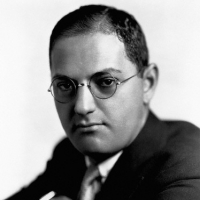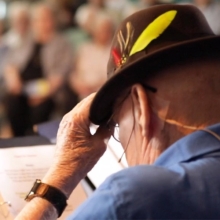Ira Gershwin

Ira Gershwin, the first lyricist to be awarded a Pulitzer Prize -- Of Thee I Sing, 1932 -- was born in New York City on December 6, 1896. (His brother, George, with whom he was to make of Gershwin a hallmark for distinguished musical-comedy songs, was born twenty-one months later in Brooklyn.) While attending the College of the City of New York, Ira began demonstrating his lifelong interest in light verse and contributed droll quatrains and squibs to newspaper columnists. In 1918 while working as the desk attendant in a Turkish bath, he tentatively began a collaboration with his brother, and their The Real American Folk Song (Is a Rag) was heard in Nora Bayes s Ladies First. Not wanting to trade on the success of his already famous brother, Ira soon afterward adopted the nom de plume of Arthur Francis, combining the names of his youngest brother Arthur and sister Frances. Under this pen name in 1921 Ira supplied lyrics for his first Broadway show, Two Little Girls in Blue, with music by another newcomer, Vincent Youmans.
After writing songs for three more years with a variety of composers Ira was ready in 1924 to begin the successful and lifelong collaboration with George and dropped the pseudonym. Thus it was as the Gershwin Brothers that George and Ira created the hit, Lady, Be Good!, featuring Fred and Adele Astaire, the first of the Gershwins more than twenty scores for stage and screen, including Oh, Kay! for Gertrude Lawrence; two versions of Strike Up the Band (1927 & 1930); Ethel Merman s introduction to Broadway, Girl Crazy (1930); Shall We Dance (1937), one of Hollywood s stylish pairings of Fred Astaire and Ginger Rogers; and the triumphant opera, Porgy and Bess, written with DuBose Heyward. Before and after George s death in 1937 Ira also collaborated with such composers as Harold Arlen (A Star Is Born, 1954), Vernon Duke (The Ziegfeld Follies of 1936), Kurt Weill (Lady in the Dark, 1941), Jerome Kern (Cover Girl, 1944), Harry Warren (The Barkleys of Broadway, 1949; the final Astaire/Rogers picture), Arthur Schwartz (Park Avenue, 1946) and Burton Lane (Give a Girl a Break, 1953).
For his achievements in film scores Ira Gershwin was nominated three times for an Academy Award for the songs They Can t Take That Away From Me, Long Ago (and Far Away) (his biggest song hit in any one year) and The Man That Got Away. In 1966 he received a Doctor of Fine Arts degree from the University of Maryland, confirming the judgment of so many of his literary admirers -- writers like Dashiell Hammett, Lillian Hellman, Dorothy Parker, S.N. Behrman, P.G. Wodehouse, W.H. Auden, Ogden Nash, and Larry Hart, to name only a few -- that his work was not only of the first rank, but that the Gershwin standards set new standards for the American musical theatre. Small wonder that the Gershwin oeuvre has been taken up enthusiastically by a younger generation who have delighted in the new Gershwin musicals, My One and Only (1983) and the 1992 Tony Award winner for best musical, Crazy for You.
In all the years after George s death, Ira assiduously attended to the Gershwin legacy of songs, show and film scores, and concert works. Ira annotated all the materials that pertain to the careers of his brother and himself before donating them to the Library of Congress to become a part of our national heritage. In 1985 the United States Congress recognized this legacy by awarding the Congressional Gold Medal to George and Ira Gershwin, only the third time in our nation s history that songwriters had been so honored. On August 17, 1983, Ira Gershwin died peacefully at the Gershwin Plantation, the Beverly Hills home that since 1940 he had shared with Leonore, his wife of 56 years, to whom he had dedicated his unique compendium of lyrics, musings, observations and anecdotes: the critically acclaimed Lyrics on Several Occasions (1959, 1997).





